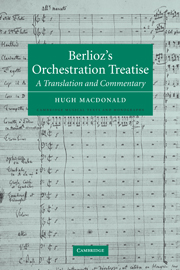Book contents
- Frontmatter
- Contents
- List of illustrations
- Preface
- A note on the edition
- A note on the translation
- Acknowledgments
- List of abbreviations
- The Treatise
- Introduction
- 1 Bowed strings
- 2 Plucked strings
- 3 Strings with keyboard
- 4 Wind: Introduction
- 5 Wind with reeds
- 6 Wind without reeds
- 7 Wind with keyboard
- 8 Brass with mouthpiece
- 9 Woodwind with mouthpiece
- 10 Voices
- 11 Pitched percussion
- 12 Unpitched percussion
- 13 New instruments
- 14 The orchestra
- 15 The conductor and his art
- Appendix: Berlioz's writings on instruments
- Bibliography
- General index
- Index of Berlioz's works
12 - Unpitched percussion
Published online by Cambridge University Press: 22 September 2009
- Frontmatter
- Contents
- List of illustrations
- Preface
- A note on the edition
- A note on the translation
- Acknowledgments
- List of abbreviations
- The Treatise
- Introduction
- 1 Bowed strings
- 2 Plucked strings
- 3 Strings with keyboard
- 4 Wind: Introduction
- 5 Wind with reeds
- 6 Wind without reeds
- 7 Wind with keyboard
- 8 Brass with mouthpiece
- 9 Woodwind with mouthpiece
- 10 Voices
- 11 Pitched percussion
- 12 Unpitched percussion
- 13 New instruments
- 14 The orchestra
- 15 The conductor and his art
- Appendix: Berlioz's writings on instruments
- Bibliography
- General index
- Index of Berlioz's works
Summary
THE BASS DRUM
Of all percussion instruments of indeterminate pitch it is surely the bass drum which has caused the most devastation and led to the worst abuses and excesses of modern music. None of the great composers of the last century thought to include it in the orchestra. Spontini was the first to use it, in the triumphal march in La vestale, and then a little later in several scenes in Fernand Cortez, where it is fittingly used. But to write for it in the fashion of the last fifteen years in every ensemble, every finale, every little chorus, in ballets, even in cavatinas, is the ultimate in absurdity and – let's call things by their name – in brutality. It's not as though composers even had the excuse of an original rhythm which they might be supposed to be emphasising in contrast to subsidiary rhythms. No, they bash the strong beats of every bar, they drown the orchestra and obliterate the voices. No melody or harmony or phrase or expression survives. Even the key can be drowned. Then they imagine they have devised a forceful style of instrumentation and created something beautiful!
I need hardly add that in this way of doing things the bass drum is almost always accompanied by the cymbals, as if the two instruments were inseparable by nature.
- Type
- Chapter
- Information
- Berlioz's Orchestration TreatiseA Translation and Commentary, pp. 280 - 295Publisher: Cambridge University PressPrint publication year: 2002

